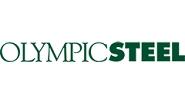Steel Mills

Profitable Year for Olympic Steel
Written by Sandy Williams
March 4, 2018
Metals service center Olympic Steel announced its most profitable year since 2011. Operating income was $24 million and net income $19 million. Net sales increased 26 percent in 2017 to $1.3 billion on higher average selling prices and shipping volume.
“Demand for metals improved during 2017, driven by stronger GDP growth in the U.S. and abroad,” said Chairman and CEO Michael Siegal.
“Improving economic conditions have revitalized the U.S. manufacturing sector. Our customers are currently benefiting from recent tax legislation and higher capital equipment spending, and stand to gain further from potential infrastructure investments,” Siegal said. “We enter 2018 primed for growth and expect to prosper in this environment.”
Fourth-quarter sales increased 21 percent to $308 million. Sales included 258,074 tons of carbon flat products and 21,175 tons of specialty metals flat products. Average selling price per ton during the fourth quarter was $774 per ton, and $758 per ton for full-year 2017.
Sales of flat rolled products increased 30 percent in 2017 and 20 percent for specialty metals and tubular and pipe.
The company profited from the tax reform legislation, recording a net tax benefit of $2.6 million. Olympic’s effective tax rate will be in the range of 27-28 percent, down from 38-39 percent previously.
A new cut-to-length line is scheduled to come online at the end of the year, as well as a second slitter, at Olympic’s Streetsboro, Ohio, facility. The company is also investing in flat and tube laser cutting equipment to meet customer demand.
Siegal said Olympic Steel plans to move forward much more aggressively on mergers and acquisitions. “We’ve got a very successful group of younger managers. When we say younger, they’re all in their late 30s, early 40s, not to diminish people who are in their 50s or 60s. But we’ve got a great group of young, aggressive managers that want us to grow and want the same opportunity that we had.”
Siegal noted significant increases in freight rates. “The difficulty everybody across the sector is having is finding truck drivers in an environment where we’re seeing more retail establishment shift as it relates to the Amazons, now beginning their own trucking. UPS and FedEx are basically targeting long-haul drivers and offering a pretty robust package.”
Customers were taken by surprise regarding the Section 232 tariff, said Siegal, and customer concern has risen considerably. “Certainly there is a fear of not just pricing, but availability. And as this plays out, it’s our desire to take care of those customers in the best way possible.”
President David Wolfort referred to infrastructure as the “third leg of the stool” for the Trump administration. “There was legislative impasse as we look at the president’s policies going into early fourth quarter and that gave people some consternation,” said Wolfort. “And then as we moved through October, which was a pause in the marketplace, I think everyone started to understand that Section 232 was complicated and it was for real and that tax reform was obviously for real. I think that the infrastructure program, although its design is still fluid, is the third leg of that stool.”
He added, “Clearly, the legislative agenda that this president has outlined he’s fulfilling and that infrastructure will very much be embraced and very much needed.”

Sandy Williams
Read more from Sandy WilliamsLatest in Steel Mills

AISI: Raw steel production backs off multi-year high
US raw steel output edged lower last week after hitting a multi-year high in mid-June, according to the American Iron and Steel Institute (AISI).

Private equity firm Atlas Holdings to acquire Evraz North America
Atlas Holdings said it has signed a definitive agreement to acquire Evraz North America (Evraz NA). The Greenwich, Conn.-based private equity firm said it expects the deal for the Chicago-based steelmaker to close in the second quarter of 2025 subject to various closing condition.

Granite City Works must remain open and other terms of the Nippon-USS deal
SEC documents also name Trump specifically as having veto power certain decisions are part of the “Golden Share” provision.

USS shuffles some leadership roles after close of Nippon deal
USS shuffles leadership deck after deal closes with Nippon.

ArcelorMittal fires up steelmaking at Calvert mill
With the marking of the EAF’s first heat earlier this month, the mill has moved from a rerolling and finishing mill to a full steelmaking facility.
